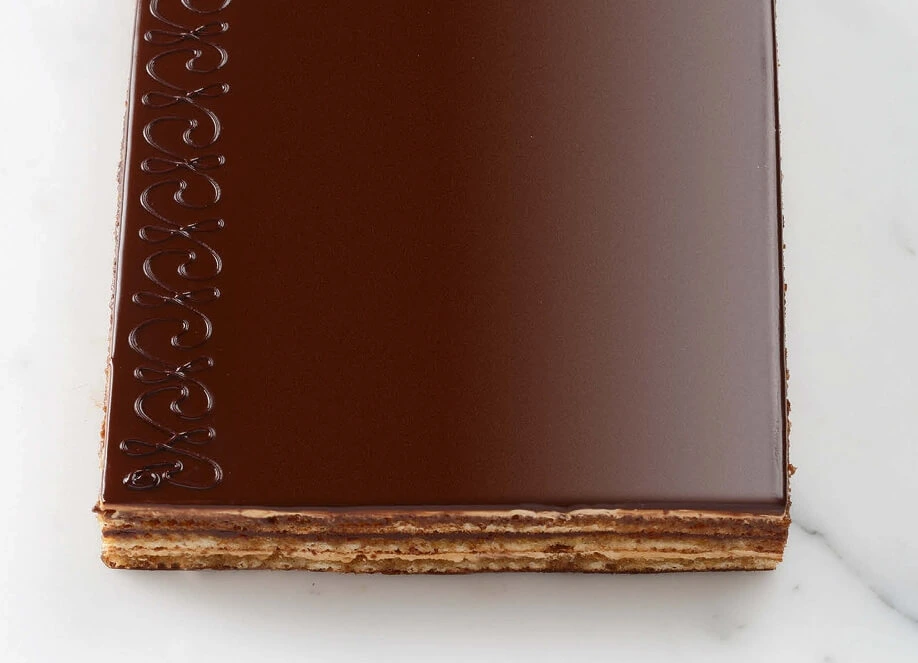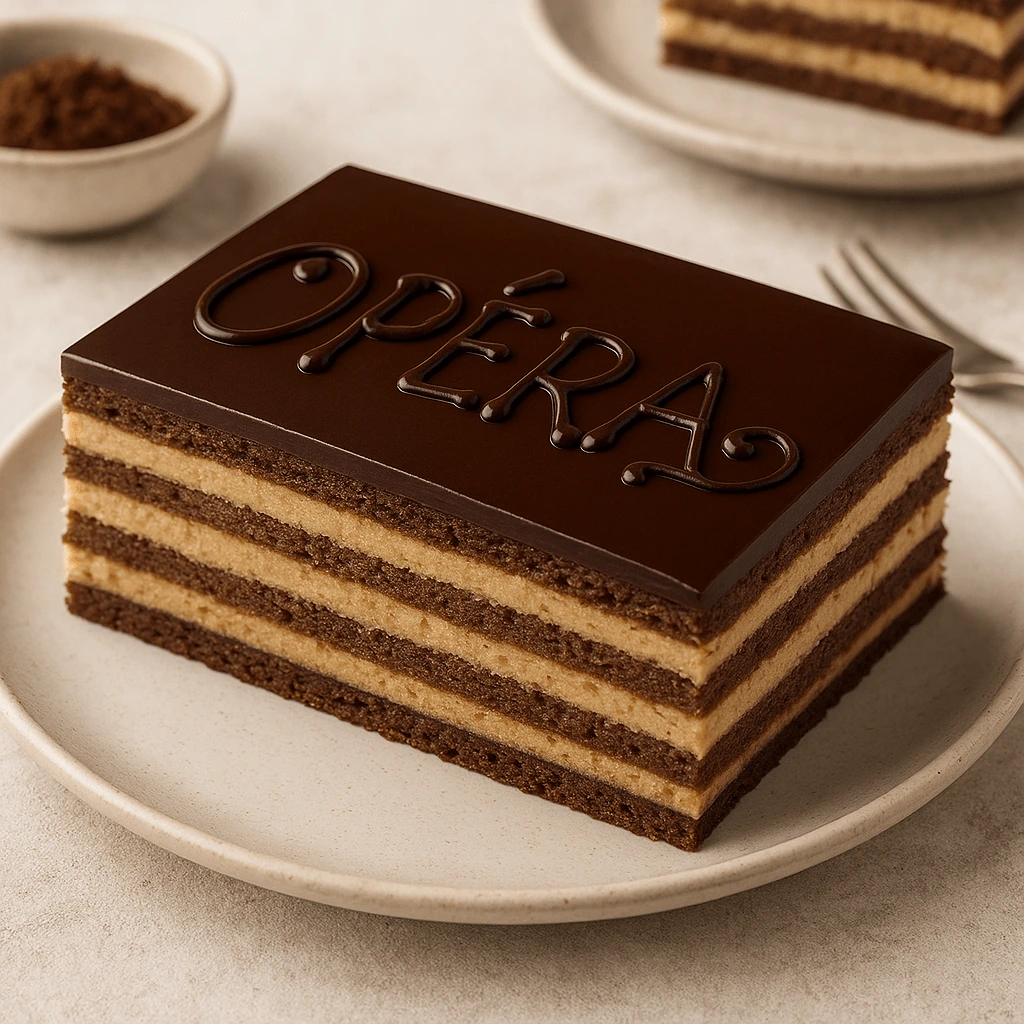Opéra cake French pastry
The Opéra cake is more than just a dessert—it is a performance in layers, a culinary overture composed of finesse, balance, and tradition. Named after the grandeur of the Paris Opera, this celebrated French entremets is a testament to the artistry and precision that define haute pâtisserie.
Its origins trace back to mid-20th century Paris, most notably to the prestigious house of Dalloyau, where it was reportedly created to showcase the elegance of French pastry and to offer a dessert that mirrored the sophistication of the Parisian elite. Whether or not Dalloyau was the first to assemble it, what’s undeniable is the Opéra’s place as a timeless classic in French culinary repertoire.
Visually striking and architecturally refined, the Opéra is instantly recognizable by its clean, horizontal layers. Each layer contributes a unique texture and flavor, yet the experience is one of seamless harmony. A bite reveals alternating bands of almond sponge delicately soaked with coffee syrup, enveloped in rich coffee buttercream and dark chocolate ganache. The ensemble is sealed beneath a thin, glossy chocolate glaze, often inscribed with the word “Opéra” in an elegant script.
What elevates this dessert to near-legendary status is not only its rich flavor profile—an interplay of deep coffee notes and bittersweet chocolate—but also the precision required in its execution. The layers must be impeccably even, the finish smooth, and the balance of intensity and lightness carefully maintained. In the world of pâtisserie, it is both a rite of passage and a showcase of technical mastery.
Beyond its flavors,
the Opéra is steeped in cultural resonance. It evokes the grandeur of a night at the opera house, where every element—from the overture to the final bow—is crafted to leave an impression. The cake, similarly, offers a moment of refined indulgence, where taste, texture, and technique come together in perfect cadence.
Often served chilled, the Opéra gains character as it rests, allowing its layers to meld and its aromas to deepen. Whether presented as a slice or as an individual portion, it never fails to impress—its sharp edges and lacquered finish reflecting the discipline and luxury of classic French dessert-making.
To enjoy an Opéra is to taste tradition, elegance, and the quiet drama of pâtisserie at its finest.
For 6 to 8 servings
Timing
- Preparation: 2 hours
- Baking: 8 minutes
- Chilling: 1 hour
- Storage: Keeps for 3 days in the refrigerator (airtight container)
Equipment
- Stand mixer
- Cooking thermometer
- Immersion blender
- Square cake frame (12 cm x 12 cm, 2.5 cm high)
- Pastry brush
Ingredients
JOCONDE SPONGE
- 150 g whole eggs
- 115 g icing sugar
- 115 g almond flour
- 45 g melted butter
- 30 g all-purpose flour
- 105 g egg whites
- 15 g granulated sugar
COFFEE BUTTERCREAM
- 100 g water
- 100 g granulated sugar
- 125 g egg whites
- 325 g unsalted butter
- Coffee extract, to taste
CHOCOLATE GANACHE
- 160 g whole milk
- 35 g heavy cream (35% fat)
- 125 g dark chocolate (64% cocoa)
- 65 g unsalted butter
COFFEE SOAKING SYRUP
- 750 g water
- 62 g granulated sugar
- 62 g instant espresso powder
CHOCOLATE GLAZE
- 100 g dark coating paste (pâte à glacer brune)
- 100 g dark chocolate (58% cocoa)
- 50 g grapeseed oil
Joconde Sponge
In the bowl of a stand mixer fitted with the whisk attachment, beat the eggs at high speed for 5 minutes with the icing sugar, almond flour, melted butter, and flour. Set this mixture aside. In a clean bowl, whip the egg whites until soft peaks form, then add the sugar to stabilize them. Gently fold the meringue into the first mixture. Spread the batter onto a baking sheet and bake at 220°C (430°F / Gas Mark 7–8) for 5 to 8 minutes. Let cool.
Coffee Buttercream
In a saucepan, heat the water and sugar until it reaches 117°C (243°F). Slowly pour the hot syrup over the egg whites, which have been whipped to a light foam in the bowl of a stand mixer. Beat the mixture on medium speed until it cools to 20–25°C (68–77°F). Incorporate the softened butter and continue mixing until smooth and creamy. Add coffee extract to taste. Refrigerate until ready to use.
Chocolate Ganache
In a saucepan, bring the milk and cream to a boil. Pour over the chopped chocolate and stir with a spatula until combined. Add the softened butter in small pieces. Blend with an immersion blender until smooth and glossy. Set aside.
Coffee Syrup
In a saucepan, heat the water and sugar. Once dissolved, stir in the instant espresso powder. Let cool completely.
Assembly
Cut the cooled joconde sponge into three 12 cm x 12 cm squares. On the underside of one sponge layer, spread a very thin layer of melted chocolate, place it on a presentation board, and allow it to set. Using a pastry brush, generously soak the top with coffee syrup. Spread an even layer of coffee buttercream over the sponge.
Soak both sides of the second sponge square with syrup, place it on top, and cover with a layer of ganache.
Repeat with the third sponge: soak with syrup, place it on top, and finish with a smooth layer of coffee buttercream. Chill the assembled cake for 1 hour.
For the glaze, gently melt the dark coating paste with the chocolate in a bain-marie or microwave. Stir in the grapeseed oil. Once the cake is thoroughly chilled, pour the glaze evenly over the top. Allow to set before serving.
Chef’s Tips for a Perfect Opéra Cake:
- Joconde Sponge:
- Ensure your egg whites are whipped to stiff peaks before folding them into the almond mixture. This will ensure your sponge is light and airy.
- Don’t over-bake the Joconde sponge. It should be golden and soft to the touch but not dry. This is key for the moist texture of the cake layers.
- Buttercream:
- When making the buttercream, allow the sugar syrup to cool before adding it to the egg whites. This step is critical for achieving the perfect texture.
- The butter must be softened properly. If it’s too cold, the mixture will curdle.
- Ganache:
- For a smoother ganache, use a high-quality chocolate with at least 64% cocoa content. It will ensure a rich, glossy finish.
- Mix the ganache gently with a spatula to avoid introducing air bubbles.
- Soaking Syrup:
- Make sure to let the coffee syrup cool completely before using it on the sponge. This ensures that it absorbs perfectly without making the cake soggy.
- Glaze:
- When applying the glaze, be sure the cake is completely chilled. This ensures the glaze sets smoothly and doesn’t drip.
- If the glaze isn’t shiny enough, a little more oil can be added to achieve that perfect sheen.
Serving:
Allow the Opéra cake to sit at room temperature for about 15 minutes before serving. This allows the flavors to really come together, and the texture will be more balanced.

Conclusion:
Creating an Opéra Cake at home is a true testament to your passion for baking and love for intricate, high-end desserts. This iconic French masterpiece, with its harmonious layers of almond sponge, rich coffee buttercream, and velvety ganache, is not just a treat for the palate, but a feast for the eyes as well. Whether you’re making it for a special occasion or as a personal indulgence, the Opéra cake offers an unforgettable experience that will leave a lasting impression on anyone who tastes it.
Though the process requires patience and precision, the payoff is undoubtedly worth it. With each layer meticulously built and each flavor expertly balanced, the Opéra Cake stands as a perfect example of the artistry in French pâtisserie. Once you’ve mastered this classic, you’ll find yourself eager to share it with loved ones or even showcase it at a gathering as a showstopping centerpiece.
Question and Answer:
Q: How long does it take to make an Opéra Cake?
Making an Opéra Cake can take a bit of time, especially for the first attempt, but it’s worth every minute. The preparation will take about 2 hours, followed by 8 minutes of baking, 1 hour of refrigeration, and then the final glazing and assembly. All in all, you can expect around 3 hours of hands-on work, but the cake needs at least an hour to chill before it’s ready to be served.
Q: Can I make an Opéra Cake in advance?
Yes, you can definitely make the Opéra Cake in advance. In fact, the flavors develop even more beautifully if left to rest for a day or two. Just make sure to store it in the fridge, as the ganache and buttercream need to stay cool. The cake will last for up to 3 days in the fridge, but it’s best enjoyed within the first 24–48 hours for optimal freshness.
Q: Can I substitute the coffee flavor with something else?
While coffee is a key ingredient in the classic Opéra Cake, you can absolutely experiment with flavors to suit your taste. Some bakers opt for chocolate or vanilla syrups, or even fruit-based infusions like raspberry. However, if you want the true, traditional Opéra Cake experience, coffee is essential.
Q: What if I don’t have a pastry frame or mold?
If you don’t have the specific 12 cm pastry frame or mold, you can easily adapt. You can assemble the cake directly on a baking sheet and trim the layers to fit once assembled, or use any other rectangular or square mold you have available. Just make sure the layers are even for a beautiful presentation.
Q: How can I make the cake more beginner-friendly?
If you’re new to baking, don’t be discouraged! You can simplify the process by using store-bought components, like a pre-made buttercream or ganache. While the result may not be as authentic as making it from scratch, it can still be a delicious and fun way to practice assembling layers. Additionally, you can start by preparing just the Joconde sponge and experimenting with the other parts over time.http://Pierre Hermé’s Interpretation of Opéra – So Good Magazine
Link to https://briochechic.com/crispy-caramelized-bliss6-secret-to-perfect-palmiers-revealed/#more-390

